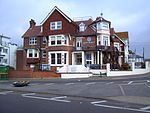Havens, Westcliff-on-Sea
1901 establishments in EnglandBuildings and structures in Southend-on-SeaDefunct department stores of the United KingdomDefunct retail companies of the United KingdomDepartment store buildings in the United Kingdom ... and 5 more
Department stores in Southend-On-Sea (town)Department stores of the United KingdomGrade II listed buildings in EssexRetail companies established in 1901United Kingdom retail company stubs

Havens department store is a Grade II listed building based in Westcliff-on-Sea, Essex and, until its closure in 2017, it was the only remaining independent department store based in the borough of Southend-on-Sea.
Excerpt from the Wikipedia article Havens, Westcliff-on-Sea (License: CC BY-SA 3.0, Authors, Images).Havens, Westcliff-on-Sea
Hamlet Court Road, Southend-on-Sea Westcliff-on-Sea
Geographical coordinates (GPS) Address Nearby Places Show on map
Geographical coordinates (GPS)
| Latitude | Longitude |
|---|---|
| N 51.5403 ° | E 0.6952 ° |
Address
Pasterfield Estates
Hamlet Court Road
SS0 7LN Southend-on-Sea, Westcliff-on-Sea
England, United Kingdom
Open on Google Maps








